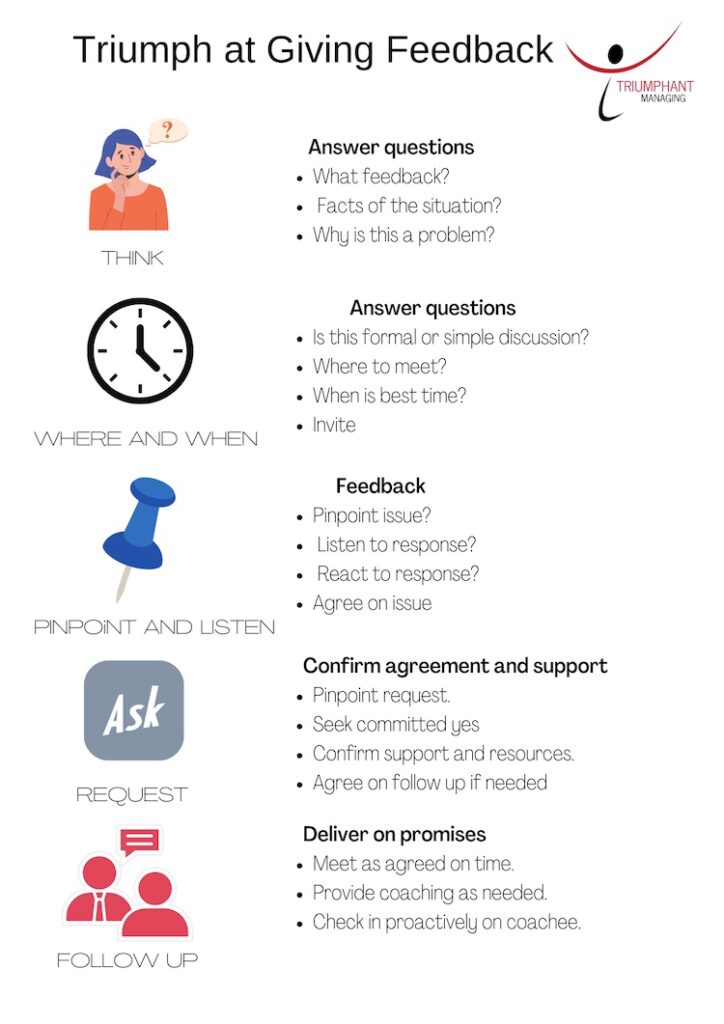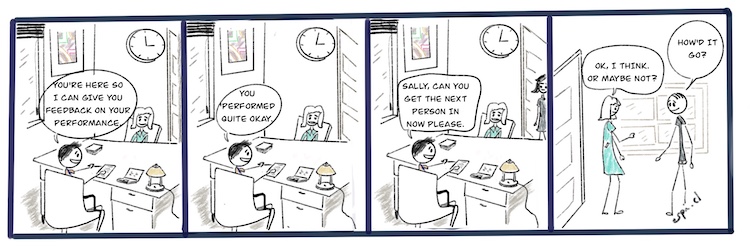If there is one thing that all MM’s dislike it is having to deal with non performance issues.
It is really the idea of telling a worker that they are not performing. Add to this that they might be ‘friends’, older than you, former peers, previous high performer, a person of the opposite sex or non-binary or gay. You will note from this list that there can be a fear of offending the individual’s view of themselves, which of course has nothing to do with non performance in the workplace. The other side of the coin is a fear that they might not like you if you give feedback and will end up having a poor relationship ongoing.
You right to give feedback, if work related, comes from your role as a MM.You are accountable for results. If someone is not delivering on the objectives for which they are responsible, means that your results are at risk. Your role as a manger means that you have to be aware of non performance and do what it takes to get it back on track. That is where feedback comes in.
Step 1 is clarity on feedback.
You know by now, that I see all work as a process and the results are what the current process produced. If I do not like a result I need to look for the root cause somewhere in the process and fix it. So feedback follows a process as well. This first step is a thinking step in which you get very clear on the specific no performance that you are observing. We call this ‘pin pointing’.
In days gone by before computers and amazing applications, field commanders used maps. Often in movies you will see officers standing round a map laid out on a larger table. On the pa are pins marking specific spots.

Step 2 is choose the venue and time for the feedback.
This will depend on the nature and seriousness of the feedback. Something simple can be in a face to face chat in a passageway or at the person’s station. A serious matter will be best if there is privacy and no interruptions.
The time will depend on the length of time it takes to have the discussion. In this article I am writing about a more serious discussion although all the steps apply equally. If you see a worker about to climb a scaffold with no safety belt in sight, you address it right there and then. Poor report writing might need more time to fully discuss it.
Step 2 ends when you have pinpointed the purpose of the discussion and asked the target of the feedback to meet with you.
Step 3 giving feedback and listening.
This covers giving the feedback and listening to the receiver of the feedback. In giving the feedback here is the sub process:
a. Treat person with respect. This is shown by your demeanour, your welcome and how you arrange the seating. It is always better to make the person feel comfortable and to sit on the same side of the desk or table or machine. It is good to sit if possible. DO not make them feel small.
b. Pinpoint the purpose of your meeting and provide the feedback. As you have clearly pre-thought the pinpointed issue , you share the issue with them. You do this in a calm voice and avoid saying anything that sounds like there is something wrong with them. Do not say “I am talking about your sloppy reporting”, rather say “ I am talking about two areas of your reporting that can be improved.” Focusing on the issue and not belittling the person is the objective.I like to hold the visual thought of sitting side by side looking at the problem as if it is on the table in front of you both.

c. Check if they understand what you have said and ask for their view of the issue. Be quiet and listen for understanding. Expect that there might be excuses, lies, denial and distraction as a person naturally tries to protect their self image, job and relationship.
This is mitigated by pinpointing the issue, not using words to put them down or describe them as being lacking in some way.
There might be new facts that you were unaware of and that modify your thinking. For example if someone has been arriving late for a cadence meeting at 8 a.m., they might share that the usual person taking the children to school is sick and the teak has fallen on them and the logistics are difficult to guarantee their arriving on time.
Handling excuses that you perceive as not valid or truthful. The simplest way is to say “I hear what you are saying, but I do not buy it.” and then revert back to the issue using your pinpointed facts. Another phrase that is helpful is “Given that that is so, it does not change the need for what I shared to be improved.
Sometimes the person feels trapped in a situation that is causing the undesired outcome. In this case it is useful to consider working with them to develop choices. Often this leads to seeing a possible way forward. A phrase that helps with these ‘stuck’ situations is “given that this has happened, what is possible now?’ This builds on the assumption that you cannot ‘unbuild’ what has happened. Starting with the current reality ‘what’s possible now?’ moves to finding different and possible ways to resolve the current situation.
The purpose of listening is threefold – 1. To surface facts of which you might be unaware. 2. To get a sense of how they are handling the feedback and the extent to which they are trying to justify it so that you can deal with their excuses. denial etc. 3. To help them see their reality in a way that helps them focus on the future and not being stuck.

Step 4 is the ASK.
What change are you asking them to make? Your ask should be actionable and measurable.
“Starting from tomorrow I want you to be in the cadence meeting on time. This means that you will …….(being the possible action(s) you worked out with them on Step 3).
Sometimes you might want to add check in points depending on the issue. In the case of a report with errors you might chose to review a draft.
In the case that learning is needed as part of the solution then you will be asking that they take the necessary actions to make this possible.
It could include supporting actions from your side. You might have made promises to help them learn or clear the way for them to succeed.
The ASK must also be pinpointed. Not “do better next time”, rather “The next report will have no errors and it will include al the salient points. I will not find that there is missing data or inaccurate data.”
Step 5 is follow up.
Sometimes there will be no formal followup agreed.
At other times you might want to review a draft or have a weekly report or meet at certain times to review progress. This will depend on the situation. If there is a specifc date for an action – add it to your calendar or you will forget it. And forgetting it senda the message “I was not really serious about my ASK”. ON the other hand, following up as agreed syas “Wow the boss was serious and next time there is feedback to them they will have this assumption in the back of their minds..
During formal follow ups go back to facts! Pinpoint what has happened. If it is good news than thank them and praise them – that is how the action and linked results will continue to occur.

